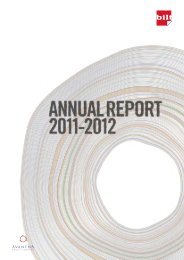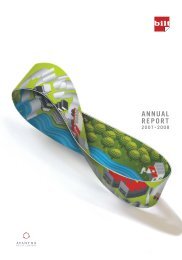Annual Report 2011 - Ballarpur Industries Limited
Annual Report 2011 - Ballarpur Industries Limited
Annual Report 2011 - Ballarpur Industries Limited
You also want an ePaper? Increase the reach of your titles
YUMPU automatically turns print PDFs into web optimized ePapers that Google loves.
8<br />
Apart from these<br />
developments, it is<br />
also important to note<br />
that your Company<br />
is growing in terms of<br />
its asset base. Pulp<br />
and paper are capital<br />
intensive businesses<br />
where investments are<br />
essential to develop<br />
optimal scale of<br />
operations, remain<br />
cost competitive and<br />
produce the appropriate<br />
quality of products.<br />
ballarpur industries limited | annual report 2010–11<br />
There are three broad facets to your<br />
Company’s performance that I must share<br />
with you.<br />
First, in a competitive market environment,<br />
BILT succeeded in raising sales volumes,<br />
which was the principal driver of growth.<br />
Operationally, this was possible through<br />
efficient management of the supply chain,<br />
greater utilisation of new capacities that came<br />
on-stream in the last couple of years, as well<br />
as a judicious mix of product positioning<br />
and distribution. Your Company’s sales<br />
and marketing activities were planned and<br />
executed very well; and BILT’s product<br />
differentiation, brand positioning, sales and<br />
distribution have been fundamental to the<br />
Company’s overall growth model.<br />
On a broader perspective, your Company<br />
is following a two-pronged market positioning<br />
strategy. For one, it pushes for attaining<br />
leadership position in its primary markets,<br />
India and Malaysia, where it has its<br />
manufacturing facilities. These are growing<br />
economies with strong internal demand that<br />
is fairly insulated from trends in the developed<br />
world. Here, the focus is on being a trendsetter,<br />
and growing its business with the<br />
expansion of the markets. For another, BILT is<br />
utilising its competitive strength as a low cost<br />
manufacturer of quality products to grow its<br />
exports. In 2010-11, your Company exported<br />
14 per cent of its volumes produced in India,<br />
over a significantly higher base.<br />
Second, EBIDTA margins were under<br />
pressure. Even after significant improvements<br />
in operating efficiencies, sharp increase<br />
in prices of key inputs like pulp and coal<br />
contributed to a 2 percentage point drop in<br />
the PBDIT/Sales margin. July-December<br />
2010 saw robust demand growth across<br />
global economies, especially in large<br />
developing nations. This created supply-side<br />
constraints for several commodities, including<br />
wood pulp and coal. Your Company had to<br />
buy large amounts of pulp from the open<br />
market which increased our raw material<br />
costs. Moreover, much of the coal price hike<br />
could not be passed on to customers.<br />
I believe that the margin drop is a temporary<br />
phenomenon, and that your Company has<br />
a strategy in place to counter this external<br />
exigency.<br />
It consists of making investments to<br />
enhance BILT’s pulp production for captive<br />
use. An additional 120,000 tonnes per<br />
annum (tpa) of pulp capacity at SFI (Malaysia)<br />
is expected to come on-line in October <strong>2011</strong>,<br />
while an extra 170,000 tpa of pulp capacity<br />
is expected to be commissioned at <strong>Ballarpur</strong><br />
by June 2012. With these expansions, BILT<br />
will have largely integrated pulp and paper<br />
operations, which should insulate your<br />
Company’s operations from sharp rises in<br />
market price of pulp.<br />
I expect the management to get back to<br />
higher EBIDTA margins after the additional<br />
pulp capacities come into play.<br />
Third, there was a strong performance of<br />
the rayon grade pulp (RGP) business out of<br />
Kamalapuram. In an environment of supply<br />
side constraints with growing demand, pulp<br />
prices remained firm throughout 2010-11.<br />
This included rayon grade pulp that is used<br />
in the production of viscose staple fibre.<br />
Your Company capitalised on the prevailing<br />
market conditions and increased production<br />
at its RGP unit at Kamalapuram in 2010-11.<br />
This volume growth coupled with higher unit<br />
sales realisation translated into a 47 per cent<br />
increase in segment revenues from the pulp<br />
business to Rs.504.8 crore. The growth in<br />
RGP profits helped to partially offset the drop<br />
in margins of the core paper business.<br />
Apart from these developments, it is<br />
also important to note that your Company<br />
is growing in terms of its asset base. Pulp<br />
and paper are capital intensive businesses<br />
where investments are essential to develop<br />
an optimal scale of operations, remain cost<br />
competitive and produce the appropriate<br />
quality of products. In 2010-11 alone, the<br />
total capital employed increased by 15 per<br />
cent to Rs.7,409 crore. This will increase<br />
further with the investments in the new pulp<br />
facilities in <strong>Ballarpur</strong> and SFI.<br />
This quantum of investments requires<br />
astute financing. So far, your Company has<br />
been successful in optimally raising capital<br />
from various markets across the globe. For<br />
this purpose, the consolidated entity of<br />
your Company has a complex structure of<br />
subsidiaries and step-down subsidiaries.<br />
Though intricate, the structure has played a<br />
major role in helping to break the business<br />
into portfolios and get different investors with<br />
varied objectives to invest into BILT through<br />
different schemes.<br />
On 5 August <strong>2011</strong>, <strong>Ballarpur</strong> International<br />
Graphic Paper Holdings (BIGPH), a stepdown<br />
subsidiary, successfully completed<br />
its debut transaction in the international<br />
bond markets by raising US$ 200 million<br />
in perpetual non-callable 5/10 year bonds<br />
offering at a rate of 9.75 per cent per annum.<br />
This was done through dollar-denominated<br />
Subordinated Perpetual Capital Securities (or





